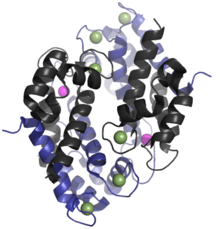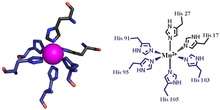Calprotectin
Calprotectin is a complex of the mammalian proteins S100A8 and S100A9.[1][2] In the presence of calcium, calprotectin is capable of sequestering the transition metals iron,[3] manganese and zinc[2][4] via chelation.[5] This metal sequestration affords the complex antimicrobial properties.[2][4] Calprotectin is the only known antimicrobial manganese sequestration protein complex.[6] Calprotectin comprises as much as 60% of the soluble protein content of the cytosol of a neutrophil,[2][7][8] and it is secreted by an unknown mechanism during inflammation.[9] Faecal calprotectin has been used to detect intestinal inflammation (colitis or enteritis) and can serve as a biomarker for inflammatory bowel diseases and rheumatoid arthritis. [7][10] Other names for calprotectin include MRP8-MRP14, calgranulin A and B, cystic fibrosis antigen, L1, 60BB antigen, and 27E10 antigen.[2][9]
Structure

The human homologue of calprotectin is a 24 kDa dimer,[6] and is formed by the protein monomers S100A8 (10,835 Da) and S100A9 (13,242 Da).[11][12] The primary structure of calprotectin can vary between species. For instance, the mouse homologue of S100A8 is 10,295 Da,[13] while the S100A9 homologue is 13,049 Da.[14] Early size exclusion chromatography experiments incorrectly indicated that calprotectin had a molecular mass of 36.5 kDa;[2][8] occasionally this value is used in contemporary literature. Calprotectin S100A8-S100A9 dimers can non-covalently pair with one another to form 48 kDa tetramers.
Metal binding
Calprotectin has a high affinity for calcium, zinc, iron, and manganese.[7][8][15][3] Each of S100A8 and S100A9 contain two EF-hand type Ca2+ binding sites,[6][9] and calprotectin is able to bind a total of four calcium ions per dimer or eight calcium ions per tetramer.[16] Calcium binding induces a conformational change in the complex that improves its affinity for transition metals, and promotes tetramer formation.[2][6] A maximum of two transition metal ions may bind to each calprotectin S100A8-S100A9 dimer.[6]
A calprotectin dimer can bind only one manganese or iron ion with high affinity, and it can do this only in the presence of calcium.[6][17][3] Zinc can bind at two sites within the calprotectin dimer, and this can occur in the absence of calcium.[2] Calcium, however, improves calprotectin's affinity for zinc.[6] While calprotectin metal binding occurs at the interface of S100A9 and S100A8 monomers, the independent monomers have some capacity for zinc binding, and may contribute to zinc homeostasis within mammals.[2][11][12]

The first of the two calprotectin metal binding sites consists of a His3Asp motif, with S100A8 contributing two histidine ligands (His83 and His87), and S100A9 contributing a histidine and an aspartic acid ligand (His20 and Asp30).[6] The second site can coordinate metals through a tetra-histidine (His4) or a hexa-histidine (His6) binding motif. In the case of His4 binding, S100A8 coordinates through both His17 and His27 while S100A9 coordinates through His91 and His95.[6] In hexa-histidine binding two further histidine residues, His103 and His105, are recruited from the C-terminal end of S100A9 to enable octahedral coordination of the transition metal.[6] Manganese or iron are bound by the calprotectin dimer at this His6 site.[6][3] Zinc can be bound to either of the sites that form at the interface between S100A8 and S100A9 monomers.[6][17]
Inflammatory disease
Calprotectin constitutes up to 60% of soluble protein content in the cytosol of neutrophil granulocytes,[2][7][8] and it can be found at a lower concentration in monocytes, macrophages, and squamous epithelial cells.[2][7][8] Calprotectin enters into pus and abscess fluid during neutrophil cell death, along with other antimicrobial proteins.[2]
Mammalian cells secrete calprotectin during the inflammatory response. Plasma calprotectin is elevated in persons with metabolic syndrome, a disease characterized by chronic inflammation.[18] Calprotectin is secreted in the mouth during inflammation of the gingiva and during oral candidiasis infection.[19][20] People who have mutations in the calprotectin gene appear susceptible to serious gum infections.[19] Manganese sequestration by calprotectin is likely important during lung inflammation.[4] The exact mechanism by which S100A8 and S100A9 is secreted by mammalian cells during inflammation remains unknown.[9]
Antimicrobial properties
Transition metals are essential to the survival of all organisms.[21] Mammals strictly limit metal availability as a part of the innate immune system, and this helps prevent infection by microbes and fungi.[21] Calprotectin was first described in the 1980s as a mammalian antimicrobial protein that acts through the sequestration of zinc.[1][2][6] It is now known that calprotectin also has antibacterial and antifungal properties that arise from its ability to sequester manganese and iron.[4][6][3] Calprotectin is the only known antimicrobial agent that acts through manganese sequestration.[6]
Faecal calprotectin
Calprotectin becomes available in the intestinal lumen via leukocyte shedding,[1] active secretion,[2][8] cell disturbance, and cell death.[1][8] This results in elevated faecal calprotectin levels, which can be detected in the stool.[1][8] Elevated faecal calprotectin levels therefore indicate migration of neutrophils into the intestinal mucosa, which occurs during intestinal inflammation.[1][8][15] As people with active inflammatory bowel diseases (IBD) such as ulcerative colitis or Crohn disease have as much as a 10-fold increase in faecal calprotectin levels,[7] the measurement of faecal calprotectin can serve as a biochemical test for these diseases.
Although a relatively new test, faecal calprotectin is regularly used as an indicator for IBD during treatment and as a diagnostic marker.[10] Faecal calprotectin tests can also function in distinguishing patients with irritable bowel syndrome from those with IBD.[1][8] Calprotectin is useful as a marker, as it is resistant to enzymatic degradation, and can be easily measured in faeces.[22] Although faecal calprotectin correlates significantly with disease activity in people with confirmed IBD,[23] elevated faecal calprotectin can be a false-positive indicator of IBD under some conditions. Importantly, intake of proton pump inhibitor is associated with significantly elevated calprotectin values.[24] Furthermore, positive faecal calprotectin does not help in localizing IBD, or in distinguishing ulcerative colitis from Crohn's disease.[1] Faecal calprotectin can also indicate other gastrointestinal conditions such as colorectal cancer, gastroenteritis, and food intolerance.[1] Calprotectin levels vary depending on age, comorbidity, and may vary day-to-day within individuals.[1] Faecal calprotectin could be used as a preliminary screen in otherwise functional patients suspected of having IBD, or as a means of following mucosal healing.[1] The potential for using faecal calprotectin in this way is debated, however, and cut-off levels have not been agreed upon.[1]
See also
- Zinc in biology
- Manganese in biology
- Nutritional role of calcium
- Bioinorganic Chemistry
References
- Lehmann FS, Burri E, Beglinger C (January 2015). "The role and utility of faecal markers in inflammatory bowel disease". Therapeutic Advances in Gastroenterology. 8 (1): 23–36. doi:10.1177/1756283X14553384. PMC 4265086. PMID 25553077.
- Stríz I, Trebichavský I (2004). "Calprotectin - a pleiotropic molecule in acute and chronic inflammation". Physiological Research. 53 (3): 245–53. PMID 15209531.
- Nakashige TG, Zhang B, Krebs C, Nolan EM (October 2015). "Human calprotectin is an iron-sequestering host-defense protein". Nature Chemical Biology. 11 (10): 765–71. doi:10.1038/nchembio.1891. PMC 4575267. PMID 26302479.
- Costa, Lucio G; Aschner, Michael (2014). Manganese in Health and Disease. Royal Society of Chemistry. p. 146. ISBN 978-1849739436. Retrieved 27 January 2015.
- Clark, HL; et al. (2016), "Zinc and manganese chelation by neutrophil s100a8/a9 (calprotectin) limits extracellular Aspergillus fumigatus hyphal growth and corneal infection", J Immunol, 196 (1): 336–344, doi:10.4049/jimmunol.1502037, PMC 4684987, PMID 26582948.
- Brophy MB, Nolan EM (March 2015). "Manganese and microbial pathogenesis: sequestration by the Mammalian immune system and utilization by microorganisms". ACS Chemical Biology. 10 (3): 641–51. doi:10.1021/cb500792b. PMC 4372095. PMID 25594606.
- Marshall, William Marshall; Lapsley, Marta; Day, Andrew; Ayling, Ruth (2014). Clinical Biochemistry: Metabolic and Clinical Aspects (3 ed.). Elsevier Health Sciences, 2014. ISBN 9780702054785. Retrieved 19 January 2015.
- Gupta, Ramesh (2014). Biomarkers in toxicology. San Diego, CA: Academic Press. pp. 272–273. ISBN 9780124046498. Retrieved 19 January 2015.
- Celio, Marco R.; Pauls, Thomas; Schwaller, Beat (1996). Guidebook to the calcium-binding proteins. Oxford: Sambrook & Tooze Publication at Oxford University Press. pp. 147–148. ISBN 0198599501.
- van Rheenen PF, Van de Vijver E, Fidler V (July 2010). "Faecal calprotectin for screening of patients with suspected inflammatory bowel disease: diagnostic meta-analysis". BMJ. 341: c3369. doi:10.1136/bmj.c3369. PMC 2904879. PMID 20634346. Lay summary – MedScape.
- UniProt Consortium. "P05109- S10A8_HUMAN". www.uniprot.org. UniProt Consortium. Retrieved 21 January 2015.
- UniProt Consortium. "P06702- S10A9_HUMAN". www.uniprot.org. UniProt Consortium. Retrieved 21 January 2015.
- UniProt Consortium. "P27005- S10A8_MOUSE". www.uniprot.org. UniProt Consortium. Retrieved 21 January 2015.
- UniProt Consortium. "P31725- S10A9_MOUSE". www.uniprot.org. UniProt Consortium. Retrieved 21 January 2015.
- Evans, G.O. (2009). Animal Clinical Chemistry: A Practical Handbook for Toxicologists and Biomedical Researchers (2 ed.). Boca Raton: Taylor & Francis. pp. 107–108. ISBN 9781420080124. Retrieved 19 January 2015.
- Strupat K, Rogniaux H, Van Dorsselaer A, Roth J, Vogl T (September 2000). "Calcium-induced noncovalently linked tetramers of MRP8 and MRP14 are confirmed by electrospray ionization-mass analysis". Journal of the American Society for Mass Spectrometry. 11 (9): 780–8. doi:10.1016/s1044-0305(00)00150-1. PMID 10976885.
- Maret, Wolfgang; Wedd, Anthony (2014). Binding, transport and storage of metal ions in biological cells. [S.l.]: Royal Soc Of Chemistry. p. 271. ISBN 9781849735995. Retrieved 27 January 2015.
- Pedersen L, Nybo M, Poulsen MK, Henriksen JE, Dahl J, Rasmussen LM (December 2014). "Plasma calprotectin and its association with cardiovascular disease manifestations, obesity and the metabolic syndrome in type 2 diabetes mellitus patients". BMC Cardiovascular Disorders. 14: 196. doi:10.1186/1471-2261-14-196. PMC 4289556. PMID 25527236.
- Schaechter, Moselio (2009). Encyclopedia of microbiology (3 ed.). [S.l.]: Elsevier. p. 570. ISBN 978-0123739445. Retrieved 27 January 2015.
- Vacharaksa, Anjalee (2007). Restricted HIV-1 Infection Increases Susceptibility of Candida Infection in Oral Keratinocytes. p. 20. ISBN 9780549367666. Retrieved 27 January 2015.
- Hood MI, Skaar EP (July 2012). "Nutritional immunity: transition metals at the pathogen-host interface". Nature Reviews. Microbiology. 10 (8): 525–37. doi:10.1038/nrmicro2836. PMC 3875331. PMID 22796883.
- Tibble J, Teahon K, Thjodleifsson B, Roseth A, Sigthorsson G, Bridger S, Foster R, Sherwood R, Fagerhol M, Bjarnason I (October 2000). "A simple method for assessing intestinal inflammation in Crohn's disease". Gut. 47 (4): 506–13. doi:10.1136/gut.47.4.506. PMC 1728060. PMID 10986210.
- D'Haens G, Ferrante M, Vermeire S, Baert F, Noman M, Moortgat L, Geens P, Iwens D, Aerden I, Van Assche G, Van Olmen G, Rutgeerts P (December 2012). "Fecal calprotectin is a surrogate marker for endoscopic lesions in inflammatory bowel disease". Inflammatory Bowel Diseases. 18 (12): 2218–24. doi:10.1002/ibd.22917. PMID 22344983.
- Poullis A, Foster R, Mendall MA, Shreeve D, Wiener K (May 2003). "Proton pump inhibitors are associated with elevation of faecal calprotectin and may affect specificity". European Journal of Gastroenterology & Hepatology. 15 (5): 573–4, author reply 574. doi:10.1097/00042737-200305000-00021. PMID 12702920.